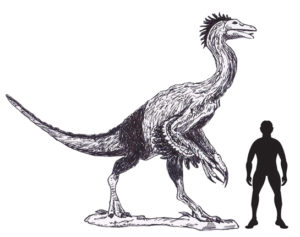Super-sized “Ostrich-like” Dinosaur from China
A new giant ornithomimid named Beishanlong grandis from Gansu Province (China).
Over the last two summers, an international team of palaeontologists have been excavating a number of new dinosaur specimens from Cretaceous aged strata in the southern part of the Gobi desert (Gansu Province, China). A number of new discoveries have been made including an ancestor of Tyrannosaurus rex (Xiongguanlong baimoensis), pronounced shong-GWAN-long by-mo-EN-sis. The name is a bit of a mouthful, which is appropriate for this meat-eating dinosaur as it had at least 70 sharp teeth in its jaws. The name means Grand Pass Dragon of the White Ghost, in reference to the area the fossils were found and their proximity to a geological feature called the “White Ghost Castle”.
The new tyrannosaur and a huge ornithomimid (ostrich-mimic), another type of theropod from these sediments are described in detail in the on-line journal of the Proceedings of the Royal Society B this week. Further detailed information on these two discoveries will be published in a special volume entitled “Recent advances in Chinese Palaeontology”, in recognition of the enormous volume of vertebrate fossils that have been discovered in China over the past few years.
The ornithomimid has been named Beishanlong grandis, pronounced bay-SHAN-long gran-DIS. It may be the largest ornithomimid discovered to date. Size estimates are difficult to pin down as to date only a partial skeleton has been discovered. From these remains (part of a forelimb, leg-bones, tail chevrons and caudal vertebra the animal has been estimated to have stood at least 3 metres high at the hips and weighed over 600 kilograms, that’s over four times the weight of a male ostrich.
A Scale Drawing of the Newly Described Ornithomimid Beishanlong grandis
Picture credit: Everything Dinosaur
The scale drawings the new ornithomimid compared to an adult human. The bones in the diagrams provided by the research team represent those parts of the fossil skeleton discovered to date.
The ornithomimids (members of the Dinosaur family Ornithomimosauria), are regarded as ostrich mimics. Their anatomy resembles extant ground dwelling birds such as ostriches, emus and rheas. They were lightly built, with compact bodies, long legs, a long neck and a small head. They majority of these type of dinosaurs had toothless beaks just like birds.
Research project leader Peter Makovicky commented:
“When I first saw the fossils I thought, this dinosaur is much bigger than it should be, so it took a while to identify, but it’s really cool”.
Analysis of the micro-structure of fossilised bone indicates that this particular dinosaur was aged about 14 years when it died. It was still actively growing and had not reached full size. The joint US/Chinese team are looking forward to unearthing even bigger specimens of this type of theropod in the near future.
The strata from which these two dinosaurs have been recovered has been dated to approximately 120 million years ago, placing these animals in the Early Cretaceous.
To view replicas of theropod dinosaurs including tyrannosaurids and ornithomimids, take a look at the models section of Everything Dinosaur’s website: Dinosaur and Prehistoric Animal Models.







Leave A Comment